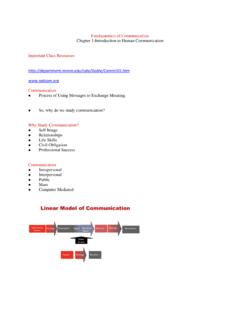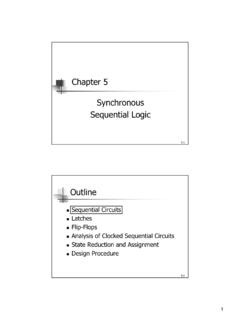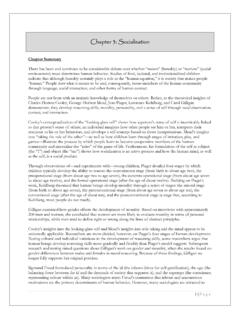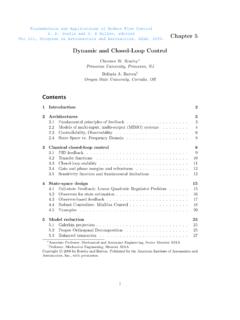Transcription of Chapter 9 Asynchronous Sequential Logic
1 19-1 Chapter 9 AsynchronousSequential Logic9-2 Outline Asynchronous Sequential Circuits Analysis Procedure Circuits with Latches Design Procedure Reduction of State and Flow Tables Race-Free State Assignment Hazards Design Example29-3 Sequential Circuits Consist of a combinational circuit to which storage elements are connected to form a feedback path Specified by a time sequence of inputs, outputs, and internal states Two types of Sequential circuits: Synchronous Asynchronousprimary difference9-4 Synchronous vs. Asynchronous Asynchronous Sequential circuits Internal states can change at any instantof time when there is a change in the input variables No clocksignal is required Have better performance but hard to design due to timing problems Synchronous Sequential circuits Synchronized by a periodictrain of clock pulses Much easier to design(preferred design style)39-5 Why Asynchronous Circuits ? Used when speed of operation is important Response quickly without waiting for a clock pulse Used in small independent systems Only a few components are required Used when the input signals may change independently of internal clock Asynchronous in nature Used in the communication between two units that have their own independent clocks Must be done in an Asynchronous fashion9-6 Definitions of Asyn.
2 Circuits Inputs / Outputs Delay elements: Only a short term memory May not really exist due to original gate delay Secondary variable: Current state (small y) Excitation variable: Next state (big Y) Have some delay in response to input changes49-7 Operational Mode Steady-state condition: Current states and next states are the same Difference between Y and y will cause a transition Fundamental mode: No simultaneous changes of two or more variables The time between two input changes must be longer than the time it takes the circuit to a stable state The input signals change one at a time and only when the circuit is in a stable condition9-8 Outline Asynchronous Sequential Circuits Analysis Procedure Circuits with Latches Design Procedure Reduction of State and Flow Tables Race-Free State Assignment Hazards Design Example59-9 Transition Table Transition table is useful to analyze an Asynchronous circuit from the circuit diagram Procedure to obtain transition table:1. Determine all feedback loops in the circuits2.
3 Mark the input (yi) and output (Yi) of each feedback loop3. Derive the Boolean functions of all Y s4. Plot each Y function in a map and combine all maps into one table5. Circle those values of Y in each square that are equal to the value of y in the same row9-10An Example of Transition TableY1= xy1+ x y2Y2= xy 1+ x y2feedbackfeedbackinputscurrentstatesY = Y1Y2stable !!69-11 State Table When input x changes from 0 to 1 while y=00: Y changes to 01 unstable y becomes 01 after a short delay stable at the second row The next state is Y=01 Each row must have at least onestable state Analyze each state in this way can obtain its state table011111010001101110100000X=1X=0 StateNext StatePresenty1y2x :total state4 stable total states:000,011,110,1019-12 Flow Table Similar to a transition table except the states are represented by letter symbols Can also include the output values Suitable to obtain the Logic diagram from it Primitive flow table:only onestablestate in each row(ex: 9-4(a))Equivalent to 9-3(c) ifa=00, b=01, c=11, d=1079-13 Flow Table to Circuits Procedure to obtain circuits from flow table: Assign to each state a distinct binary value(convert to a transition table) Obtain circuits from the map Two difficulties: The binary state assignment (to avoid race) The output assigned to the unstable statesEx.
4 From the flow table 9-4(b)9-14 Race Conditions Race condition: two or morebinary state variables will change value when one input variable changes Cannot predict state sequence if unequal delay is encountered Non-critical race: The final stable state does notdepend on the change order of state variables Critical race: The change order of state variables will result in differentstable states Should be avoided !!89-15 Race-Free State Assignment Race can be avoided by proper state assignment Direct the circuit through intermediate unstable states with a unique state-variable change It is said to have a cycle Must ensure that a cycle will terminate with a stable state Otherwise, the circuit will keep going in unstable states More details will be discussed in Section 9-69-16 Stability Check Asynchronous Sequential circuits may oscillate between unstable states due to the feedback Must check for stability to ensure proper operations Can be easily checked from the transition table Any column has no stable states unstable Ex: when x1x2=11 in Fig.
5 9-9(b), Y and y are never the sameY = x 1x2+ x2y 99-17 Outline Asynchronous Sequential Circuits Analysis Procedure Circuits with Latches Design Procedure Reduction of State and Flow Tables Race-Free State Assignment Hazards Design Example9-18 Latches in Asynchronous Circuits The traditional configuration of Asynchronous circuits is using one or more feedback loops No real delay elements It is more convenient to employ the SR latch as a memory element in Asynchronous circuits Produce an orderly pattern in the Logic diagram with the memory elements clearly visible SR latch is also an Asynchronous circuit Will be analyzed first using the method for Asynchronous circuits109-19SR Latch with NOR GatesfeedbackS=1, R=1 (SR = 1)should not be used SR = 0 isnormal mode*should be carefullychecked first9-20SR Latch with NAND GatesfeedbackS=0, R=0 (S R = 1)should not be used S R = 0 isnormal mode*should be carefullychecked first119-21 Analysis Procedure Procedure to analyze an Asynchronous Sequential circuits with SR latches:1.
6 Label each latch output with Yiand its external feedback path (if any) with yi2. Derive the Boolean functions for each Siand Ri3. Check whether SR=0 (NOR latch) or S R =0 (NAND latch) is satisfied4. Evaluate Y=S+R y (NOR latch) or Y=S +Ry(NAND latch)5. Construct the transition table for Y= Circle all stable states where Y=y9-22 Analysis ExampleS1=x1y2R1=x 1x 2 S1R1= x1y2x 1x 2= 0 (OK)S2=x1x2R2=x 2y1 S2R2= x1x2x 2y1= 0 (OK)feedbackY1=S1+ R 1y1=x1y2+ (x1+x2)y1=x1y2+x1y1+x2y1Y2=S2+ R 2y2=x1x2+ (x2+y 1)y2=x1x2+x2y2+y 1y2critical race !!129-23 Implementation Procedure Procedure to implement an Asynchronous Sequential circuits with SR latches:1. Given a transition table that specifies the excitation function Y = , derive a pair of maps for each Siand Riusing the latch excitation table2. Derive the Boolean functions for each Siand Ri(do not to make Si and Ri equal to 1 in the same minterm square)3. Draw the Logic diagram using klatches together with the gates required to generate the S and R(for NAND latch, use the complemented values in step 2)9-24 Implementation Exampley = 1 (outside) 0 (inside) S=0, R=1 from excitation tableExcitation table: list the required S and Rfor each possible transition from y to Y139-25 Debounce Circuit Mechanical switches are often used to generate binary signals to a digital circuit It may vibrate or bounce several times before going to a final rest Cause the signal to oscillate between 1 and 0 A debounce circuit can remove the series of pulses from a contact bounce and produce a single smooth transition Position A (SR=01) bouncing (SR=11) Position B (SR=10)Q = 1 (set) Q = 1 (no change) Q = 0 (reset)9-26 Outline Asynchronous Sequential Circuits Analysis Procedure Circuits with Latches Design Procedure Reduction of State and Flow Tables Race-Free State Assignment Hazards Design Example149-27 Design Procedure1.
7 Obtain a primitive flow table from the given design specifications2. Reduce the flow table by merging rows in the primitive flow table3. Assign binary state variables to each row of the reduced flow to obtain the transition table4. Assign output values to the dashes associated with the unstable states to obtain the output map5. Simplify the Boolean functions of the excitation and output variables and draw the Logic diagram9-28 Primitive Flow Table Design example: gated latch Accept the value of D when G=1 Retain this value after G goes to 0 (D has no effects now) Obtain the flow table by listing all possible states Dash marks are given when both inputschange simultaneously Outputs of unstable states are don t careAfter state e100fAfter states b or f101eAfter state c001dAfter states a or d000cD=Q because G=1111bD=Q because G=1010aCommentsQGDS tateOutputInput159-29 Reduce the Flow Table Two or more rows can be merged into one row if there are non-conflictingstatesand outputsin everycolumns After merged into one row.
8 Don t care entries areoverwritten Stable states and outputvalues are included A common symbol is givento the merged row Formal reduction procedureis given in next section9-30 Transition Table and Logic Diagram Assign a binary value to each state to generate the transition table a=0, b=1 in this example Directly use the simplified Boolean function for the excitation variable Y An Asynchronous circuit without latch is produced169-31 Implementation with SR LatchListed according tothe transition tableand the excitationtable of SR latch9-32 Outputs for Unstable States Objective: no momentary false outputs occur when the circuit switches between stable states If the output value is not changed, the intermediate unstable state must have the same output value 0 1 (unstable) 0 (X) 0 0 (unstable) 0 (O) If the output value changed,the intermediate outputsare don t care It makes no difference whenthe output change occurs01179-33 Outline Asynchronous Sequential Circuits Analysis Procedure Circuits with Latches Design Procedure Reduction of State and Flow Tables Race-Free State Assignment Hazards Design Example9-34 State Reduction Two states are equivalent if they have the same outputand go to the same(equivalent) next statesfor each possible input Ex: (a,b) are equivalent(c,d) are equivalent State reduction procedureis similar in both sync.
9 &async. Sequential circuits For completely specified state tables: use implication table For incompletely specified state tables: use compatible pairs01dbd01dac10adb10bcax=1x=0x=1x=0 StateOutputNext StatePresent189-35 Implication Table Method (1/2)01dae00bcf01eag01dad10fgc00aeb00bda x=1x=0x=1x=0 StateOutputNext StatePresent Step 1: build the implication charta b iff d eb c since outputsare not equivalentd and e arethe same9-36 Implication Table Method (2/2)00acf01dad10fdc00adax=1x=0x=1x=0 StateOutputNext StatePresent Step 2: delete the node with unsatisfied conditions Step 3: repeat Step 2 until equivalent states founda fbecause c db fbecause c eequivalent states :(a,b) (d,e) (d,g) (e,g)*Reduced State Table*d == e == g199-37 Merge the Flow Table The state table may be incompletely specified Some next states and outputs are don t care Primitive flow tables are always incompletely specified Several synchronous circuits also have this property Incompletely specified states are not equivalent Instead, we are going to find compatible states Two states are compatible if they have the same outputand compatible next stateswhenever specified Three procedural steps: Determine all compatible pairs Find the maximal compatibles Find a minimal closed collection of compatibles9-38 Compatible Pairs Implication tables are used to find compatible states We can adjust the dashes to fit any desired condition Must have no conflictin the output values to be mergedoutputconflict !
10 Outputconflict !compatible pairs :(a,b) (a,c) (a,d)(b,e) (b,f)(c,d) (e,f)209-39 Maximal Compatibles A group of compatibles that contains all the possible combinations of compatible states Obtained from a merger diagram A line in the diagram represents that two states are compatible n-state compatible n-sided fully connected polygon All its diagonalsconnected Not allmaximalcompatiblesare necessary9-40 Closed Covering Condition The set of chosen compatibles must cover all the states and must be closed Closed covering The closure condition is satisfied if There are no implied states The implied states are includedwithin the set Ex: if remove (a,b) in the right (a,c,d) (b,e,f) are left in the set All six states are still included No implied states according toits implication table 9-23(b)219-41 Closed Covering Example*(a,b) (c,d,e) (X)implied (b,c) is notincluded in the set* better choice:(a,d) (b,c) (c,d,e)all implied statesare included9-42 Outline Asynchronous Sequential Circuits Analysis Procedure Circuits with Latches Design Procedure Reduction of State and Flow Tables Race-Free State Assignment Hazards Design Example229-43 Race-Free State Assignment Objective: choose a proper binary state assignment to prevent critical races Only one variable can change at any given time when a state transition occurs States between which transitions occur will be given adjacentassignments Two binary values are said to be adjacent if they differ in onlyone variable To ensure that a transition table has no critical races, every possible state transition should be checked A tedious work when the flow table is large Only 3-row and 4-row examples are demonstrated9-443-Row Flow Table Example (1/2) Three states require two binary variables Outputs are omitted for simplicity Adjacent info.


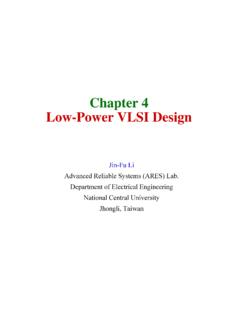



![Training Course of Design Compiler [相容模式]](/cache/preview/c/f/6/f/4/1/7/2/thumb-cf6f4172c80a30be0667109e5a50ce98.jpg)
![hspice tutorial.ppt [相容模式] - ee.ncu.edu.tw](/cache/preview/0/1/e/d/5/5/6/4/thumb-01ed55640fe3958cfb144af3846e1fcf.jpg)


